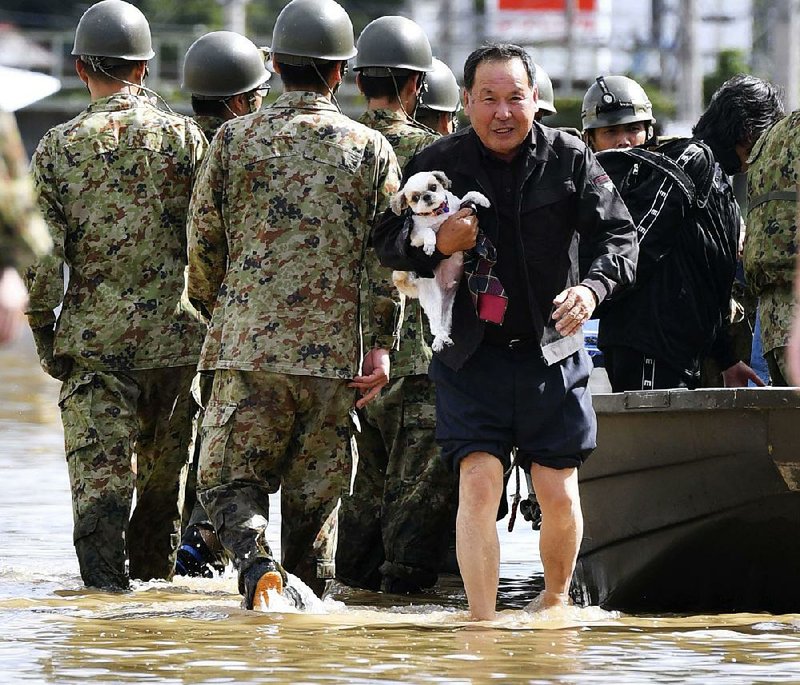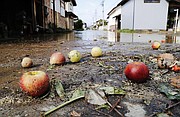TOKYO -- Helicopters, boats and thousands of troops were deployed across Japan to rescue people stranded in flooded homes Sunday as the death toll from a ferocious typhoon climbed to as high as 33. One woman fell to her death as she was being placed inside a rescue helicopter.
Typhoon Hagibis made landfall south of Tokyo on Saturday evening and battered central and northern Japan with torrents of rain and powerful gusts of wind. The typhoon was downgraded to a tropical storm on Sunday.
Public broadcaster NHK said 14 rivers across the nation had flooded, with some spilling out in more than one spot.
The Tokyo Fire Department said a woman in her 70s was accidentally dropped 131 feet to the ground while being transported into a rescue helicopter in Iwaki city in Fukushima prefecture, a northern area devastated by the typhoon.
Department officials held a news conference to apologize -- bowing deeply and long, in accordance with Japanese custom -- and acknowledged the woman had not been strapped in properly.
The government's Fire and Disaster Management Agency, which tends to be conservative in its counts, said late Sunday that 14 people had died, 11 were missing and 187 were injured as a result of the typhoon. It said 1,283 homes were flooded and 517 were damaged, partially or totally.
[Video not showing up above? Click here to watch » https://www.youtube.com/watch?v=rsfog-x0BNs]
Japanese media tallies were higher. The Kyodo News agency reported that 33 people died and 19 were missing.
"The major typhoon has caused immense damage far and wide in eastern Japan," government spokesman Yoshihide Suga told reporters.
With levees failing around the country, residents sought help escaping from flooding in multiple regions, including some urban areas. Much of Nagano city, a large prefectural capital -- and host of the 1998 Winter Olympics -- was submerged under muddy water after a levee burst on the Chikuma River. A hospital flooded in Setagaya, a wealthy ward of Tokyo.
News footage showed a rescue helicopter hovering in a flooded area in Nagano prefecture where an embankment of the Chikuma River broke, and streams of water were continuing to spread over residential areas. The helicopter rescued those stranded on the second floor of a home submerged in muddy waters.
Aerial footage showed tractors at work trying to control the flooding. Several people were seen on a rooftop, with one waving a white cloth to get the attention of a helicopter. Nearby was a child's school bag. In another part of Nagano, rows of Japan's bullet trains, parked in a facility, were in a pool of water.
In Kawagoe, a city of about 350,000 along the Oppegawa River in Saitama prefecture, the river breached its banks Saturday, flooding some neighborhoods. Inside the Kings Garden nursing home, the waters rose through the night, leaving more than 120 residents in need of rescue.
Dozens of firefighters, prefectural police and national Self-Defense Forces troops were dispatched to the area Sunday. They loaded the residents, most in their 80s and 90s and many suffering from dementia, into rubber dinghies and small motorized boats.
A section of the city of Date in Fukushima prefecture was also flooded, with only rooftops of residential homes visible in some areas, and rescuers paddled in boats to get people out. Parts of nearby Miyagi prefecture were also underwater.
In Kawasaki, an industrial city between Tokyo and Yokohama where about 900,000 people had been advised to evacuate Saturday, many areas were left underwater.
The Tama River, which runs past Tokyo, overflowed its banks, flooding homes and other buildings in the area.
Among the reported deaths were those whose homes were buried in landslides. Other fatalities included people who were swept away by raging rivers.
Early Sunday, Suga said about 376,000 homes were without electricity and that 14,000 lacked running water.
Tokyo Electric Power Co. said late Sunday that more than 66,000 homes were still without power. Tohoku Electric Co. said 5,600 homes still lacked electricity in the northern prefectures of Miyagi, Iwate and Fukushima. Both utilities said they were working to restore power.
Several train services in the Tokyo area resumed early in the morning, while others restarted later.
Ruling party politician Fumio Kishida said the government would do its "utmost" in rescue operations, including making sure that those who moved to shelters were taken care of.
He acknowledged that Japan's power grids need to be strengthened so people in disaster areas can rely on timely information.
"So many risks remain, and it is a reality that we must stay on guard," Kishida said on a news talk show on NHK. "We must do our utmost. In these times, a disaster can hit anytime."
The Rugby World Cup match between Namibia and Canada, scheduled for Sunday in Kamaishi in northern Japan, was canceled as a precautionary measure. But Japan played Scotland, to a win, as scheduled Sunday evening. Matches on Saturday had been canceled.
Stores and amusement parks had also closed, and some Tokyo stores remained closed Sunday.
As the typhoon bore down on Saturday with heavy rain and strong winds, the usually crowded train stations and bustling streets of Tokyo were deserted. But life was returning to normal on Sunday, and flights that had been grounded from Tokyo airports were gradually resuming.
Evacuation centers had been set up in coastal towns, with tens of thousands of people seeking shelter. The Kyodo News agency said evacuation warnings had been issued to more than 6 million people.
The typhoon disrupted a three-day weekend in Japan that includes Sports Day today.
Authorities had repeatedly warned that Hagibis was on par with a typhoon that wreaked havoc on the Tokyo region in 1958, but the safety infrastructure created by Japan's modernization was apparent. The typhoon six decades ago left more than 1,200 people dead and half a million houses flooded.
Information for this article was contributed by Yuri Kageyama of The Associated Press and by Motoko Rich of The New York Times.
A Section on 10/14/2019


